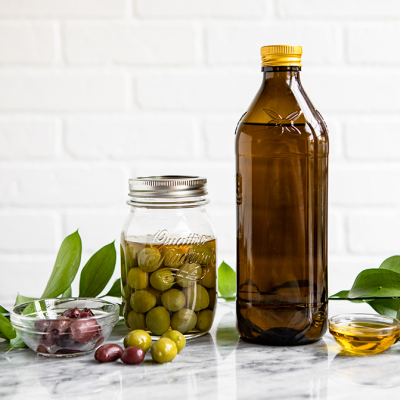The Mediterranean diet is a hot topic these days — from doctors to researchers and nutritionists, to anyone who is concerned about decreasing their inflammation and improving their overall health. With the emphasis on tons of fresh vegetables, high polyphenol meals, anti-inflammatory omega-3 fatty foods like fish and nuts and probably the most popular and well-known ingredient in Mediterranean cooking: olive oil — it’s no wonder this is a longtime trend that is here to stay.
From the beauty of both the Mediterranean landscape and the stunning people that inhabit this region, I don’t know about you, but it makes me want to cover both my salad and my skin with this luscious and highly anti-inflammatory olive oil!
Which makes sense. Ancient Egyptians used it along with beeswax as a cleanser and moisturizer. It’s had a long cosmetic and culinary history as one of the healthiest oils available and it’s believed that olives have been collected by Neolithic people as early as 8th millennium BC.
Hundreds of olive cultivars exist, some used for olive oil production, some for eating the whole fruit, others for cosmetic or industrial purposes. The specific variety of olive oil along with the timing of harvesting will impact the taste. Riper olives impart a sweeter flavor to the oil, while olives harvested earlier taste more bitter and spicy.
One of the reasons that olive oil is so healthy is due to its rich content of oleic acid. In addition to olive oil, which can be comprised of upwards of 80% or more of oleic acid, foods like avocados, tea seed oil, meat, chicken, cheese, sunflower oil, almonds, hazelnuts, pumpkin seeds, chia seeds and eggs all contain plenty of this heart-healthy fat as well.
Oleic acid is one of the major omega-9 monounsaturated fats. Unlike omega-3 and omega-6 fatty acids which are considered essential fatty acids because our bodies don’t make them, omega-9’s can be produced in the body and are clearly important for biological systems, as demonstrated by the fact that they are the most abundant fats in most of the body’s cells.
What Does the Research Suggest About Olive Oil, Oleic Acid, and Health?
- In 2009, a study found oleic acid to reverse the negative effects of the inflammatory cytokine TNF-alpha. This has particularly beneficial implications for type 2 diabetes and obesity. Dysregulation of TNF-alpha is connected to a variety of inflammatory conditions from Alzheimer’s disease, cancer, and depression.
- A 2013 study showed that higher levels of oleic acid in blood samples of adolescent boys with ADHD was positively observed with plasticity — that is, the ability for their brain to change was heightened, exhibiting in more behaviors like openness and extroversion.
- In a 2017 study, a fatty acid derivative of oleic acid provided more support of oleic acid’s role in metabolism, body composition, and weight management.
- And in 2017, a study revealed people eating a Mediterranean diet, including olive oil were shown to have increased levels of HDL, or the “good cholesterol”, known to be protective of the heart and blood vessels.
Not All Olive Oils Are Created Equal — What to Look for in a High-Quality Olive Oil
You want to make sure that all oils you consume are of the highest quality. There’s a lot to the olive oil industry with governmental bodies and agencies — like the International Olive Council to ensure regulatory standards. This is important because manufacturers’ claims can be misleading, even giving the impression that your olive oil comes from a particular place (like Italy) when it doesn’t. This can all get quite confusing, but here’s what you need to know to ensure you’re getting the highest quality olive oil around:
- Look for “Extra Virgin Olive Oil” (organic when possible) to ensure that it is pure and unrefined and was extracted by cold methods and mechanical means only, as opposed to a toxic solvent or heat. You’ll also be getting the highest levels of polyphenols, those all-important plant chemicals available to support your health, decrease cellular oxidation and inflammation. Extra virgin olive oil contains no more than .8% free acidity, which refers to the percentage of free oleic acids and is a measure of the quality.
- Buy oils that come only in dark-colored glass bottles to protect the precious fatty acids from damage from light. Oils are particularly vulnerable to damage from high temperatures, light, and oxygen. Choose glass so that you won’t get any plastic leaching into the olive oil.
- A third party certification seal will help ensure that you are getting authentic extra virgin olive oil. Look for these for added reassurance: European Union’s Protected Designation of Origin (PDO), Italy’s Protected Designation of Origin (DOP), and the California Olive Oil Council Certified Extra Virgin (COOC).
- Don’t be misled by manufacturing terms like “Pure, Classic, Light and Extra-Light” this only refers to the fact that they are made from 100% olive oil and indicate their strength of taste.
Hopefully, you’ll be inspired by the Mediterranean culture and the research on health to find ways to include this beneficial oil in your diet! From tossing fresh greens in a homemade dressing made with olive oil, to making a simple pesto with fresh herbs, olive oil, and nuts. There are countless ways to enjoy the incredible and tasty benefits of oleic acids in real, fresh, high-quality olive oil.





